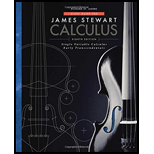
Study Guide for Stewart's Single Variable Calculus: Early Transcendentals, 8th
8th Edition
ISBN: 9781305279148
Author: Stewart, James, St. Andre, Richard
Publisher: Cengage Learning
expand_more
expand_more
format_list_bulleted
Concept explainers
Question
Chapter 10.3, Problem 2PT
To determine
To identify: The correct option for the blank in the statement, “The polar coordinates of the point with rectangular coordinates (5,5) are _____”.
Expert Solution & Answer
Want to see the full answer?
Check out a sample textbook solution
Students have asked these similar questions
Solve please thanks!
Solve please and thank you
According to Newton's law of universal gravitation, the force F between two bodies of constant mass
GmM
m and M is given by the formula F =
, where G is the gravitational constant and d is the
d²
distance between the bodies.
a. Suppose that G, m, and M are constants. Find the rate of change of force F with respect to
distance d.
F' (d)
2GmM
b. Find the rate of change of force F with gravitational constant G = 6.67 × 10-¹¹ Nm²/kg², on
two bodies 5 meters apart, each with a mass of 250 kilograms. Answer in scientific notation,
rounding to 2 decimal places.
-6.67x10
N/m syntax incomplete.
Chapter 10 Solutions
Study Guide for Stewart's Single Variable Calculus: Early Transcendentals, 8th
Ch. 10.1 - Prob. 1PTCh. 10.1 - Prob. 2PTCh. 10.1 - Prob. 3PTCh. 10.2 - Prob. 1PTCh. 10.2 - Prob. 2PTCh. 10.2 - Prob. 3PTCh. 10.2 - Prob. 4PTCh. 10.2 - Prob. 5PTCh. 10.2 - Prob. 6PTCh. 10.3 - Prob. 1PT
Ch. 10.3 - Prob. 2PTCh. 10.3 - Prob. 3PTCh. 10.3 - Prob. 4PTCh. 10.3 - Prob. 5PTCh. 10.3 - Prob. 6PTCh. 10.4 - Prob. 1PTCh. 10.4 - The area of the shaded region is given by:
Ch. 10.4 - Prob. 3PTCh. 10.5 - Prob. 1PTCh. 10.5 - Prob. 2PTCh. 10.5 - Prob. 3PTCh. 10.6 - Prob. 1PTCh. 10.6 - Prob. 2PTCh. 10.6 - Prob. 3PTCh. 10.6 - Prob. 4PT
Knowledge Booster
Learn more about
Need a deep-dive on the concept behind this application? Look no further. Learn more about this topic, calculus and related others by exploring similar questions and additional content below.Similar questions
- Solve please and thank youarrow_forwardmv2 The centripetal force of an object of mass m is given by F (r) = rotation and r is the distance from the center of rotation. ' where v is the speed of r a. Find the rate of change of centripetal force with respect to the distance from the center of rotation. F(r) b. Find the rate of change of centripetal force of an object with mass 500 kilograms, velocity of 13.86 m/s, and a distance from the center of rotation of 300 meters. Round to 2 decimal places. N/m (or kg/s²) F' (300)arrow_forwardSolve work shown please and thanks!arrow_forward
- Given the following graph of the function y = f(x) and n = = 6, answer the following questions about the area under the curve from x graph to enlarge it.) 1 (Round your answer to within two decimal places if necessary, but do not round until your final computation.) a. Use the Trapezoidal Rule to estimate the area. Estimate: T6 G b. Use Simpson's Rule to estimate the area. Estimate: S6 - ID = 0 to x = 6. (Click on aarrow_forward"Solve the following differential equation using the Operator Method and the Determinant Method:" Solve by dr no ai """'+3y"" + 3y+y=arrow_forward(4,4) M -4 2 2 -4 (-4,-4) 4 8 10 12 (8,-4) (12,-4) Graph of f The figure shows the graph of a piecewise-linear function f. For −4≤x≤12, the function g is x defined by g(x) = √ƒ (t)dt . . Find the value of g(6). Find the value of g'(6). |arrow_forward
- PREVIOUS ANSWERS ASK YOUR TEACHER PRACTICE ANOTHER Find the derivative of the function. f'(x) = X x + √3x f(x) = 3x-5 (3√√3x+11√√x+5√3 2√√x (3x-5)² Need Help? Read It SUBMIT ANSWERarrow_forwardPREVIOUS ANSWERS ASK YOUR TEACHER PRACTICE A Find the derivative of the function and evaluate f'(x) at the given val f(x) = (√√√x + 3x) (x3/2 - x); x = 1 f'(x) = 9x 412 (12x (13) 2 - 4x-3√√√x f'(1) = 2 Need Help? Read It Watch It SUBMIT ANSWERarrow_forwardConsider the following functions. g(x) = x + √3x h(x) = 3x-5 x + √3x f(x) = = 3x-5 Find the derivative of each function. g'(x) h'(x) = = f'(x) = 3 = +1 2√3x 3 (3√3x + 10√√x +5√√√3 2√√x (3x-5)² Need Help? Read It SUBMIT ANSWERarrow_forward
- "Solve the following differential equation using the Operator Method and the Determinant Method:" y'''' + 3y'"' + 3y'' + y = xarrow_forwardpractice for exam please helparrow_forwardFig. 4.22. Problems 4.1 (A). Determine the second moments of area about the axes XX for the sections shown in Fig. 4.23. [15.69, 7.88, 41.15, 24; all x 10-6 m. All dimensions in mm IAA inn 100 25 50 25 50 80 50 50 Fig. 4.23. X 80 60arrow_forward
arrow_back_ios
SEE MORE QUESTIONS
arrow_forward_ios
Recommended textbooks for you
- Algebra & Trigonometry with Analytic GeometryAlgebraISBN:9781133382119Author:SwokowskiPublisher:Cengage
 Elementary Linear Algebra (MindTap Course List)AlgebraISBN:9781305658004Author:Ron LarsonPublisher:Cengage Learning
Elementary Linear Algebra (MindTap Course List)AlgebraISBN:9781305658004Author:Ron LarsonPublisher:Cengage Learning

Algebra & Trigonometry with Analytic Geometry
Algebra
ISBN:9781133382119
Author:Swokowski
Publisher:Cengage

Elementary Linear Algebra (MindTap Course List)
Algebra
ISBN:9781305658004
Author:Ron Larson
Publisher:Cengage Learning